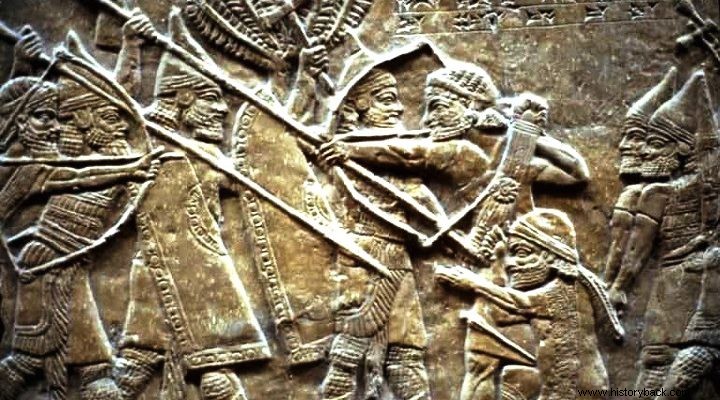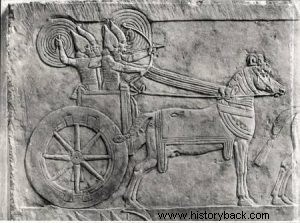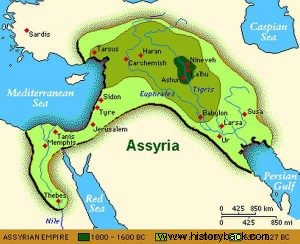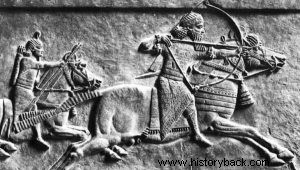
The history of Assyria is divided into three periods. The third of these, the so-called Neo-Assyrian, was the most glorious, bloody, but also destructive. The period in question begins in 745 BC. and ends in 609 BC. with the definitive dissolution of the Assyrian state
After the death of King Shalmaneser III in 824 BC. the kingdom was rocked by rebellions and civil wars. The famous Queen Semiramis (Shammurarat) and her son Adat Nirari III failed to control the forfeiture.
In 745 BC the general Pilou rebelled, conquered the throne and received the name Tiglath Pilasser III . The man in question proved to be a great reformer and reorganized the state and the army. The latter was the main support of the kingdom, but also the instrument of new conquests and consequently new profits for the empire.
The army was divided into four main divisions. The first (Kurubuti) it referred to the troops of the royal house, a kind of royal guard. The second (Kishir Saruti) it was the regular, standing army of the king. He also included many foreigners who were given Assyrian uniforms and weapons so that they would not stand out from the natives and integrate easily. The presence of Greeks is also mentioned.
The third (Sab Sari) the "king's men", were regional forces, with men who did not serve permanently. End of Dicut Mati it was the totality of those capable of bearing heavy weapons. This department was formed only in case of absolute necessity. His men were conscripted subjects, inexperienced and poorly armed.
The Kurumbuti corps formed the bodyguard of the king, queen and crown prince. Each of these three persons had his own personal guard. It consisted of heavy chariots, horsemen and elite foot soldiers. During the period of Sargon II, the king's personal guard consisted of 1,000 men.
And the Kishir Saruti consisted of units of chariots, cavalry and infantry. The infantry was distinguished into satellites, armed like the guards, with a large shield, spear and sword, and lightly armed archers and slingers. The sab shari was made up of men who owned lots of land or worked on noble estates. The corps was formed in each province when necessary, primarily constituting the provincial defense force.
The supreme commander of the army was the king (Sharum) . Immediately after were his (Tourtanou's) generals. There were two Turtanus, the one of the right horn and the one of the left. A smaller tactical subunit was the ten. A number of dozens constituted a company. A number of companies formed a Saknu which could be a battalion or regimental level group.
The lower tank unit had five vehicles. Cavalry was distinguished into two types but fought in common units with half of the men armed with bows and swords and the rest with spears and swords. It seems that the Assyrians adopted from their Elamite rivals the light chariots for transporting soldiers.
Chariots at this time were mostly quadrupeds and carried a driver and three warriors equipped with spears and bows. Assyrian heavy chariots were striking instruments like medieval knights. Their goal was the division and dissolution of the enemy.
The chariots were usually placed at the ends of the formation supported by cavalry. The cavalry, in addition to the mission of flanking, was able to move to take on missions of shock, but also of delaying and straining the enemy. There were also lightly armed horse archers who acted more as scouts and messengers.
Heavy infantry used large shields that covered the warrior from his ankles to almost his mouth. They wore helmet and breastplate and were armed with spear and sword. They were formed in a dense phalanx-type formation, but they did not use the pushing technique like the Greeks .
There were also lighter armed infantry who carried a smaller shield, spear and sword, helmet, but little or no armour. These men were more agile and could support the tanks but also fight in difficult terrain adopting loose formations.
There were also divisions of heavy archers, equipped with helmet and breastplate and armed with sword and bow. These men lined up in dense formation supporting the other infantry with their missiles. The role of supporting infantry, chariots and cavalry was also played by the light infantry, slingers and archers who fought in very loose formations. These men wore neither a helmet, nor any kind of armor, not even a shield.
Finally, Dikut Mati's hordes carried swords, spears, javelins and even agricultural tools. The Assyrians had great experience in siege operations and were among the pioneers in the manufacture of war machines.
In this period, Assyria saw great kings and conquerors, such as Sargons, Sennacherib, Esarhaddon or Ashurbanibal (the Sardanapalus of the Greeks). However, the constant civil wars for the throne exhausted the state.
The Medes, Babylonians and their allies revolted against the exhausted Assyrians and in 614 BC. they captured the capital of the state of Nineveh. The last king and son of Ashurbanibal, Sin Shar Iskun set himself on fire with his family in his palace just before the enemies entered it. Cores of the Assyrian army retreated to Haran and continued to resist until 609 BC.



